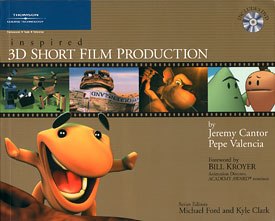Starting our Inspired excerpt series from the new book, 3D Short Film Production, authors Jeremy Cantor and Pepe Valencia take readers into the most important part of any 3D film production - the story.

A good story is the foundation of nearly every successful animated short. Strong story ingredients are essential if you expect your audience to enjoy, remember, and recommend your film. Simply dazzling your viewers with compelling visuals is sufficient if you are creating a fine arts piece in which narrative elements are intentionally absent. However, trying to hide weak story ingredients behind captivating visuals is a recipe for, at best, mediocrity. Strive for a higher standard and ground your film in a foundation of strong story elements before entering the production phase. Remember that your goal is to capture and maintain an audience's attention and you won't accomplish this mission by telling just any story. You must tell a good story.
We understand you're eager to grab your mouse and start animating, but before you do, it is important to understand some basic storytelling concepts. Remember, even the strongest presentation cannot save a poorly formed story idea.
Defining Story
The simplest definition of the word "story" is the telling or retelling of an incident or event. Stories virtually always involve something physical, mental or spiritual that changes over time, such as a location, a possession or an attitude. For example:
Once upon a time, something happened to someone, and he decided he would pursue a goal. So he devised a plan of action, and even though there were forces trying to stop him, he moved forward because there was a lot at stake. And just as things seemed as bad as they could get, he learned an important lesson, and when offered the prize he had sought so strenuously, he had to decide whether or not to take it, and in making that decision he satisfied a need that had been created by something in his past.
A journey is completed.
A problem is solved.
An item is acquired or retrieved.
A decision is made.
An opinion is reversed.
Most of the time these changes go from one extreme to the other. A good situation or person becomes bad. A fool becomes a genius. A tranquil setting erupts into chaos. Life becomes death. Often, these changes come full circle. Rags to riches to rags. Boy gets girl boy loses girl boy regains girl.
A short story is one that delivers narrative progression with economy and efficiency.
Theme
Most stories contain a central themethe main idea of the story. If you tell someone you are writing a book or making a film, he or she will likely ask what it's about (see Figure 1). If you can answer with a single word, such as "revenge," "love," "victory," "escape," "growth," "karma" or "redemption," or a short phrase such as "seize the day" or "blood is thicker than water," then you have a strong grasp of your story's central theme. To maintain a consistent vision as you assemble the elements of your film, it is often a good idea to identify this theme. In the words of Vernon Hardapple to Grady Tripp in Wonder Boys, "If you didn't know what it was about, then why were you writing it?"
[Figure 1] Even if your goal is to simply deliver a quick punch line, your story should be about something. However, dont give yourself writers block by thinking you absolutely must have a theme worked out before you begin writing. Almost every story will have a central theme, but often it wont reveal itself until much (if not all) of your script is fully written. Also keep in mind that your theme doesnt have to be especially profound. Entertainment, action and humor are perfectly acceptable themes for short animated films.
[Figure 2] Moonsung Lees Bert is both accessible and memorable because it successfully combines a familiar theme with imaginative design and art direction.
Exercise: Select a few of your favorite stories and see whether you can identify each of the central themes with a single word or a short phrase. For example, the central theme of The Wizard of Oz might be, "Home is where the heart is." The central themes of the short film Values might be "priorities" or perhaps "approval." Then again, the theme might very well be "values."
Balancing Realism with Imagination
Another important concept to keep in mind is that stories must be at least somewhat related to familiar reality to engage an audience, but abstract and creative enough to entertain. And striking this balance successfully is sometimes tricky. If your story is too close to normal reality, it runs the risk of being dull. On the other hand, if it is too bizarre you might not find an audience. Shorts like For the Birds, Bert and Early Bloomer achieve such a balance by mixing imaginative characters with familiar social themes (see Figure 2).







